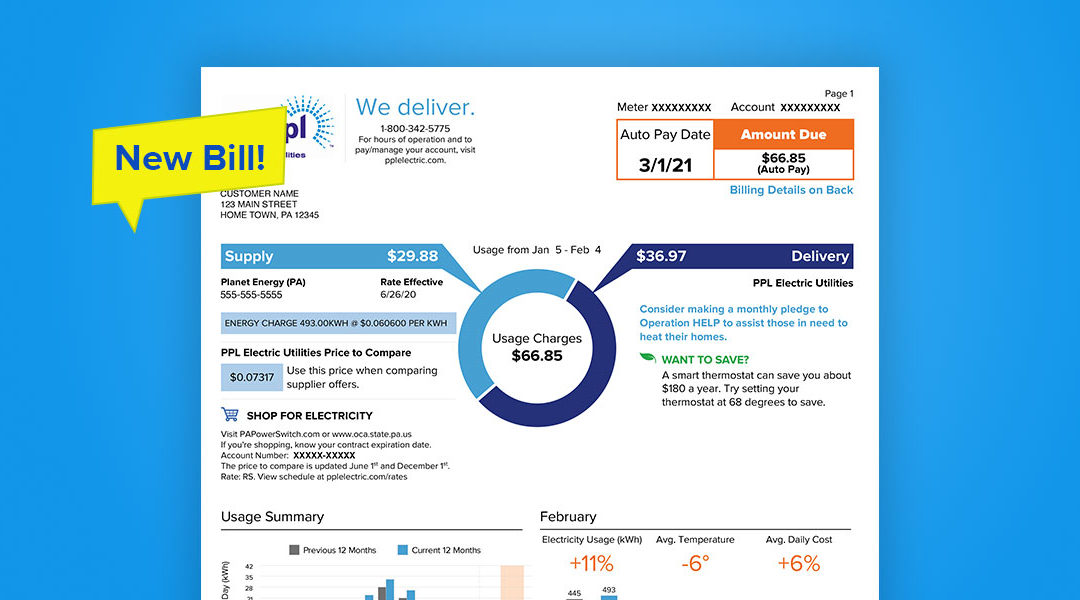
Aug 17, 2021 | Customer Service
When you receive your PPL bill – or when you view it online – this month, you’ll notice it looks a little different.
We’ve made it easier than ever for you to view your balance, make payments and manage your energy use.
You gave us feedback on the existing design and we heard you loud and clear. This new version highlights the key components of your bill, the ones that are most important to you and have the potential to help you save.
- We’ve made the supply and delivery charges front and center, so you can easily view the price you’re paying for energy supply and compare it to the PPL price-to-compare.
- The new bill displays a year-over-year comparison of your energy use, so you can make more informed energy choices.
In addition to these changes, you can see your payment amount, payment due date, and more in one quick glance.
Want a step-by-step guide to viewing your new and improved PPL bill, click here.
And if you’re not already enrolled on paperless billing, now is the perfect time to give it a try. You can switch back to a paper bill at any time, but we think you’ll love how easy it is to view your bill online, get email and text alerts, and make payments. Plus, you won’t risk any paper cuts or have to deal with envelopes and stamps! Go paperless today.

Mar 7, 2019 | Energy Future
At PPL Electric Utilities, we’ve been watching with great interest the debate surrounding the future of nuclear power.
Proposed legislation currently circulating within the Pennsylvania General Assembly would require electric utilities to purchase as much as 50 percent of customer demand from nuclear energy as part of a new mandate under Pennsylvania’s Alternative Energy Portfolio Standards Act.
We’re asking the General Assembly to seriously consider the broad impact and the unintended ramifications this aggressive proposal would have on all of our 1.4 million customers.
The conversation surrounding how to achieve long-term market-based solutions to reducing carbon is essential to Pennsylvania’s energy future. Our parent company, Pennsylvania-based PPL Corporation, supports efforts to advance a cleaner energy future and has committed reducing its carbon emissions 70 percent from 2010 levels by 2050. Additionally, PPL Electric Utilities has begun to undertake several projects that promote greater incorporation and growth of carbon-free energy sources, such as solar, onto our grid.
No one disputes that nuclear energy is carbon-free, but don’t confuse narrow nuclear subsidy proposals with efficient and effective economy-wide, market-based efforts to move the state toward a low carbon future.
This proposal, if adopted, will make Pennsylvania less competitive, impacting every electric customer in Pennsylvania and raising the average price of electricity in the state for years to come. We have estimated that our customers, alone, will pay $140 million more each year to rescue a single energy source that already benefits from an existing robust market.
If electricity customers are asked to bear this burden, customers should expect, and legislators should require that regulators have oversight. As a regulated utility, PPL Electric Utilities is required to open its books to the state’s Public Utility Commission and demonstrate a financial need before we can adjust the rates we charge to customers. Nuclear plant owners who are asking our state government to give them customer-funded financial assistance should be required to do the same. Recent draft proposals do not include this much needed requirement and also provide a subsidy for plants that are profitable.
This issue has been the focus of limited discussions for well over two years. It is only recently that proponents have turned up the heat on the General Assembly to act swiftly. Lawmakers should not fall for the “crisis” label that has been intentionally created by the bill proponents.
We’re asking lawmakers to take their time and properly vet this issue through the process — hold hearings, call in all stakeholders and most importantly, demand numbers from those advocating for this measure. Consider seeking independent audits or financial verification from outside resources available to the General Assembly.
In the end, lawmakers need to strongly consider whether hiding a nuclear bailout in customers’ electricity bills is necessary and the best course to moving Pennsylvania forward.


